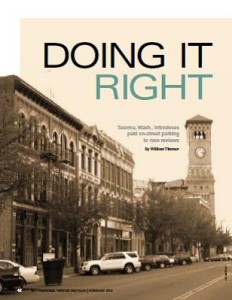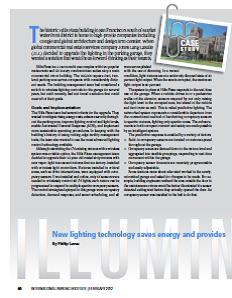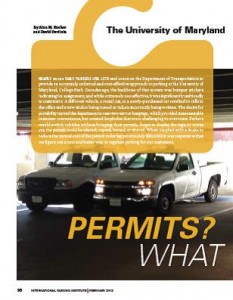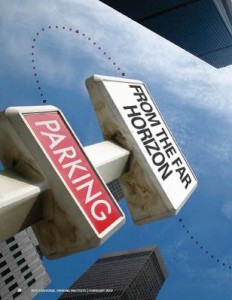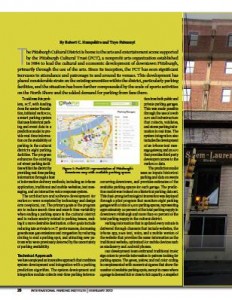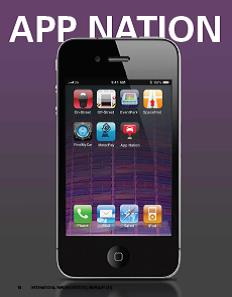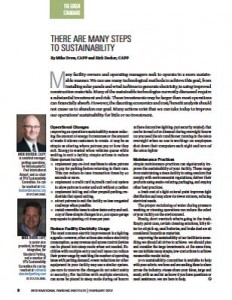Up until late 2010, Tacoma, Wash. was one of the few U.S. cities with a population of more than 200,000 that did not have some form of paid on-street parking. The downtown retail core is zoned for mixed use with commercial space for a full range of business activities. It is located between outstanding views of Mt. Rainer, Puget Sound’s Commencement Bay, and the Olympic Mountain range. There are active restaurant, museum, and theater districts. The University of Washington, Tacoma campus is located on the south edge. A mix of residential accommodations supports an active street-level retail community. Light rail serves the core from a nearby transit hub and parking complex. The 1,600 on-street spaces are complemented by about 2,500 city-owned and more than 7,800 privately owned off-street spaces.
Not unexpectedly, the free on-street spaces were heavily used. Peak occupancy exceeded 90 percent for the majority of the block faces. Survey data indicated that about half of all downtown auto trips were associated with employment travel. Of these, 59 percent of drivers regularly used on-street spaces and chain parked to avoid time limit parking citations. More than 60 percent of local merchants and their customers thought on-street parking was extremely hard to find and that the high occupancy made it difficult for customers to get to where they wanted to go.
The business community was also united in its opposition to instituting paid on-street parking. They feared paid parking would drive businesses and customers to the free parking environment at the mall located several miles south. That, they said, would turn their retail core into a ghost town.
Times change and so do parking scenarios. Today, there are about 1,500 paid on-street parking spaces in the downtown area that were designed to provide customer access. Almost every block has one to two open spaces at all times. University of Washington student bus pass purchases are up about 100 percent when compared to spring 2010 levels, and the parking program has the support of the majority of downtown stakeholders.
What caused this modern miracle in the acceptance of paid on-street parking? How was entrenched opposition to paid parking turned into active support of the program?
Trust and Transparency
The first step was to build a level of public trust in the city-directed problem solving process. There was already a general acceptance that the downtown core had an on-street parking problem that affected retail merchants. This was supported by a series of parking intercept surveys that were conducted under the guidance of the Tacoma Public Works Department. These surveys provided City Manager Eric Anderson with the background and justification to initiate an extensive public outreach program. At the same time, a group of downtown business owners began to meet to investigate possible solutions to the on-street parking problems.
Over a period of nine months, Anderson and city staff conducted a series of 16 public fact finding and feedback meetings with various members of the downtown community. The first series of meetings was designed as listening forums around the subjects of, “How is the current parking system impacting you,” and, “What are your concerns about possible solutions?” Community questions and issues were recorded and researched.
The second series of meetings focused on communicating an understanding of the concerns that were raised by the community and providing direct answers to as many of the questions as possible.
One of the key issues continued to be the perception that the city would immediately treat paid parking as an easy source of future general fund revenue. Rates would be set to fill budget gaps instead of managing customer parking access. Another concern was that the system’s operating parameters and rules would be set without considering perceived community needs. It was apparent that the downtown stake holders were concerned about losing control and influence once they agreed to drop their opposition to paid parking.
Anderson, in conjunction with the Tacoma City Council, created and passed two ordinances to directly address the issues of paid parking revenue and system control. The first created a parking enterprise fund to separate the revenues from city-controlled on- and off-street parking from the general fund. Both parking fees and parking citation revenue were directed to the enterprise fund, to be used exclusively for parking-related facilities and expenses.
The second ordinance created a permanent Parking Advisory Task Force, to be made up of volunteer representatives of the downtown stake holders group. The task force was given the responsibility to advise the city manager on parking system design and control features. This ordinance also established the principle that parking rates could be raised or lowered as necessary to achieve a 15 percent parking space vacancy rate during peak parking periods.
The original 12 task force members were selected from a group of more than 125 downtown community participants from the original series of outreach meetings. Each member was chosen to represent a cross-section of residential, business, and restaurant owner, employee, theater district, and university stake holders.
Task Force Support and Resources
With the formation of the task force, city staff quickly moved to an active supporting role in the development of a paid parking system. In addition to their role in clarifying ordinances and traffic and right-of-way requirements, they provided the task force with consultant support for meeting facilitation and on-street parking expertise. They also conducted a competitive bid and award process for a full-service parking system, including modern parking payment equipment, system installation, maintenance, and collections services.
The task force agreed to meet twice a month for the first six months of the system design and implementation process. Meetings were limited to two hours per session and led by three co-chairs, who were responsible for pre-planning each work session. Decisions on each of the work items were considered against a set of guiding principles created by the original downtown business owners group:
The on-street parking system prioritizes the customer/visitor as the desired on-street parker.
The parking system ensures a 15 percent vacancy of on-street stalls (one in six open spaces per block).
The parking system is easy to use and understand for visitors and others new to the system.
The task force’s work list included every facet of the design of the new paid parking system, including days and hours of operation, initial parking rates and durations, and sign design and pay station graphics. The typical working meeting agenda contained three to four new topics for discussion with pre-work provided the week before the meeting. As each topic reached a decision point, the task force voted for a recommended solution.
Each initial decision was held over to the following meeting to allow task force members to consult with other members of the downtown community whose interests they represented. These views were brought back at the next meeting and shared with the group. Following an open discussion of this expanded input, a final recommendation vote was conducted. These recommendations were summarized and reviewed with the city manager by the task force co-chairs.
Once a month, an hour of one of the meetings was open to the public, and community members were encouraged to attend. The public sessions included updates on system recommendations as well as an opportunity for the community to share any concerns that they might have.
Community Outreach and Involvement
In addition to the monthly community feedback meetings, the task force and city staff developed an extensive public outreach campaign. There were two key objectives of this program: the first was to proactively educate the community prior to the start of paid parking, and the second was to have the task force become the public relations interface with the community. Having messages concerning the new parking system delivered to the community by members of the community became the single most effective public relations decision made during the implementation period. The city supported these efforts by creating a parking website and an instructional video, and providing task force access to and media training from a professional public relations firm.
In practice, key task force members replied directly to public concerns either through in-person discussions, email, or the media. Most queries to city staff were referred to the task force co-chairs, who established a reputation for expeditious, consistent responses.
To proactively address community questions, city staff, particularly Parking Services Manager David Carr and members of the parking enforcement group, committed themselves to reaching as many downtown parking users as possible before the go-live date. These personal meetings and presentations were instrumental in building an outstanding community relationship, which helped maintain the positive perception of the pay station program that continues to this day. These efforts included attending numerous community events and visiting almost every downtown business, going door-to-door and store-to-store with marketing materials that explained the process. Maps showing off-street parking, brochures sharing information on alternative commuting options, and other materials helped to not only explain the program, but offer new alternatives to parking on the street all day.
Special “house parties” were also held at local businesses, giving nearby business owners the opportunity to see a live pay station demonstration and to have their questions and concerns answered. All of the comments received from these meetings were recorded and reviewed with the task force.
As part of the business community involvement, the project implementation team pre-identified the location of each
of the parking payment kiosks. Business owners were asked to comment on the proposed locations, and changes were made as necessary. This process also opened the door to addressing apprehensions, myths, and misconceptions, often on the street in front of the business. All of these actions contributed to a sense of business community input into the new paid parking system as well as a belief that unintended consequences would not be ignored.
Lessons Learned
With more than a year to reflect on the paid parking implementation process and results, there are several conclusions that can be summarized for other municipalities contemplating similar parking management changes. It is essential that both the city and the community share a common understanding of the parking problem and its associated solution objectives. Community support increases when there is a mechanism to link parking rates/revenue to system performance objectives rather than overall city budget needs. The affected stakeholders need to have real influence on system design and control parameters. And finally, the stakeholders need the time and resource support to function effectively as the face of the system to the parking public.
William Timmer is principal at Bluewater Management Services, LLC. He can be reached at wtimmer@bluewaterpm.com or 206.790.3610.

